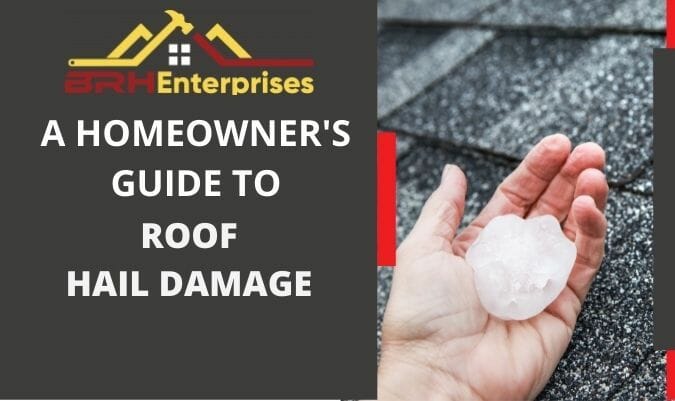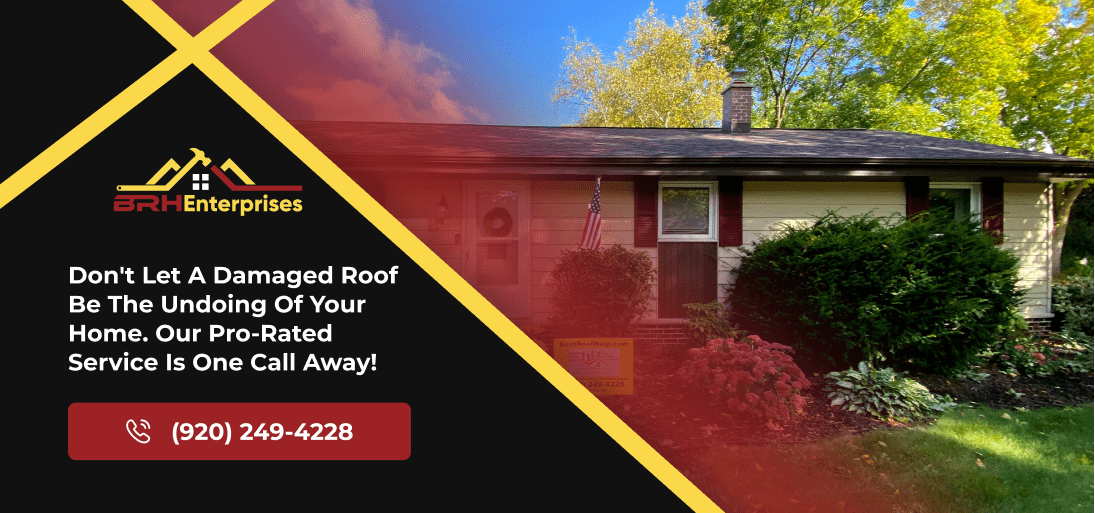A Homeowner’s Guide To Roof Hail Damage
Estimated Reading Time : 6 Min.

If you live in a region prone to severe weather, you may have seen your share of hail storms in Wisconsin. While it’s true that hail storms are common in the U.S. during the summer months of May through September, they also occur throughout the rest of the year — even in winter. And while they may not be as frequent as in spring and summer, hail storms can be just as destructive as those with a higher frequency.
While your roof and windows are the most vulnerable to hail storms, they can also damage doors, gutters, and floors. One hailstorm can cause thousands of dollars in damages — especially if you don’t catch it early. However, for those the storm has impacted, you can minimize the roof hail damage by assessing the situation and promptly making necessary repairs.
Our team at BRH Enterprises brings you a guide on how to handle roof damage caused by hail. Read on.
What Size Of Hail Will Damage A Roof?
Wisconsin hail damage occurs in all shapes and sizes — from a pinhead to the size of a golf ball. The speed that hailstones impact your roof matters, too. The following table gives a rough indication of what type of damage you might expect based on the size of a hailstone.
¾” Hail
At one-quarter inch, hail is the size of a dime. Its impact on property is less significant than larger hail but still causes damage. This size hail frequently damages vinyl siding, window screens, metal fascia, and deck paint. But we’ve also seen it remove asphalt shingle granules and damage gutters and downspouts. Unfortunately, property owners often fail to identify roof hail damage because the damage is too small to see.
1″ Hail
Once hail grows to one inch in diameter, it’s time to clean up the damage. During a hailstorm, you’ll typically see cracking and dents on the surface of your shingles. But when wind speeds are high enough during a storm, your roof can sustain significant damage from broken windows and holes in the exterior walls. The storm could also damage your gutters and downspouts, and there may be leaks in your roof.
1¼” Hail
With a hail of 1/4″ and higher, the impact of the falling ice chunks is much more severe — large holes resembling that of swiss cheese are a common sight. Smaller, softer hailstones can also cause substantial damage to roofs, windows, and siding.
1½” Hail
This hail size can break windows, dent vehicles, and cause structural damage to your roof. When a storm contains hail of this size, you need to move to a safe location or stay inside and wait for the storm to pass. You may have to replace some of your property if you don’t take proper precautions.
1¾ – 2″ Hail
This is where damage starts to get serious. With wind, hail can tear a house’s roof, leaving it open and unprotected. If you live in an area where you might encounter hail like this, make sure your roof is well covered. Full shingle coverage or good metal roof panels are the best way to protect your roof.
What Does Hail Damage Look Like On A Roof?
There are many options with varying features and benefits when it comes to roofing. It’s essential to consider your needs in terms of design and durability, and climate. Different types of tile and shingles may show different signs of roof hail damage, so it’s essential to keep an eye out for patches of peeling paint or evidence of dents or cracks.
Check Your Lawn
After the hailstorm has passed, check the area around your home for any telltale signs of roof damage. This will include broken windows and blown-off roof shingles. Also, look at your attic, garage, and gutters, which can often be tricky to spot.
Look At Roof Components
If you’re unsure what damage may have been done to your roof after a hail storm, take a closer look at the metal components. Dents, scratches, and small holes on flashings, vents, or skylights suggest there is also storm damage to the slate, tile, or wood beneath.
Check Gutters & Downspouts
While gutters can usually survive hail, large hailstones can cause damage to the gutter itself, dents in the fascia board, or even dislodge granules from the roof. Therefore, check your gutters and downspouts for signs of granule loss, which are especially noticeable if the hailstorm’s direction of approach is one side of your home.
Look At Your Shingles
If you have shingles on the edges with many granules on them, take a look above the affected area to see if there are any bare spots. It could be due to hail hitting your roof. Some other signs of roof hail damage include round or oval dents in the shingles or other forms of pitting.
Exposed Mat
The fiberglass roofing mat can be especially vulnerable to hail if exposed. If the hard, thin material of the shingles is dented, it can shatter when hit with another pebble. As more stones pelt the damaged area of your roof, the shingles will break away from the underlying mat.
Understanding The Dangers From Roof Hail Damage
Hail damage is the most widespread and, at the same time, the least noticeable — many homeowners don’t even realize they have been a victim of this type of damage. Hail can cause shingles to detach from their backing and deteriorate quickly, causing water damage inside your home. If you’re not sure whether or not you have been affected by hail-related property damage, it’s best to call for a proper inspection.
If you’ve noticed your roof is beginning to leak, it might be time to look into a repair. Unfortunately, roof leaks have a habit of causing short-term damage that can significantly strain your wallet and your home — the first step in dealing with roof leaks is stopping the water from coming inside! Luckily, BRH Enterprises has years of experience repairing hail-damaged residential roofs. You can connect with our team at any time to know how we can help you with your storm-damaged roof.
So You’ve Got a Hail-Damaged Roof: What Now?
Hail damage can be a significant problem, especially when left untreated. Water damage from hail can cause leaks and other complications, costing you thousands of dollars if not addressed promptly. There are many signs that roof hail damage has occurred, and the best thing to do is to have it inspected immediately.
It’s always a good idea to have a professional inspect the damage first — whether you’re unsure about it or not. When inspecting for damage, it’s important to remember that roofing shingles may conceal various problems underneath them, including mold and rot or an unstable structure. So even if you don’t see any visible damage, roofing professionals will know what to look for.
Does Roof Insurance Company Cover Hail Damage?
A typical homeowners insurance policy will include coverage for hail damage to the roof but may not include coverage if you live in certain state regions. Additionally, coverage may be limited if your provider is a small insurer or if you’re underinsured. This is why it is essential to understand what you are covered before making any claim.
Filing A Hail Damage Roof Insurance Claim
Are you super-curious about roof hail damage and how to file an insurance claim? We’ve got a few things you should know before filing a hail damage insurance claim.
1. Insurance Claims Are Tricky & Stressing
When disaster strikes and homes are damaged, most people don’t have time to wade through complicated insurance policies. But because many policies have clauses and stipulations that homeowners might not understand, it’s easy for scammers to prey on this confusion and take advantage of residents when they are at their most vulnerable. The roofing and insurance industries are often stigmatized for their less-than-stellar reputations. However, it’s essential to know that this isn’t always the case. Many roofers and other professionals in these industries are dedicated to providing the best service possible. Nevertheless, it’s always best to do your homework before trusting your roof.
2. Always Wait For Claim To Be Approved
Don’t sign any paperwork until your roofing insurance claim is approved. When it comes to insurance claims, the only thing that matters is what is stated in the actual documents. If you sign a contract, then submit a claim and your insurance company refuses to pay out because they disapprove of that contract language, you are on your own. No matter how good you think, your roofing company is. However, a reputable roofing contractor like BRH Enterprises will first educate you on navigating through the insurance process and how to comb through your policy. They will only talk business once your claim is approved.
Final Thoughts
Uninsured Wisconsinites can find themselves in a tough spot when filing a claim. But before you call your insurance company or agent, ask yourself: “Do I know what to expect?” It’s okay if you do not know how to find your way through this. Many people aren’t sure how the roof insurance claims process works — and once they submit a claim, they don’t know what to expect. To help them out, our team is available 24/7. Our team understands that the insurance claim process can be stressful, especially when it’s your first time experiencing a roof hail damage claim. So call today at (920) 249-4228 and let us help you make an informed decision.


